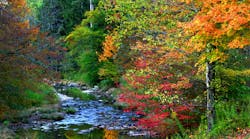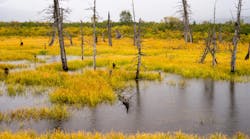As cities grow, the threat of urban runoff to nearby water systems becomes increasingly severe. Bioswales — swales with vegetation along the bottom of the channel — offer a promising solution. Understanding the benefits of bioswales and learning how these advantages work can help cities bolster their defenses against stormwater.
Many stormwater defenses and other environmental protections today center around new technologies, but solutions do not have to be high-tech to be effective. As straightforward as bioswales seem, they offer significant advantages.
Benefits of bioswales
Planning and using bioswales effectively starts with knowing how they help stormwater professionals prevent urban runoff. Here are four of the biggest benefits of bioswales.
Stormwater absorption
Bioswales’ strongest advantage is their ability to absorb stormwater so it does not run into polluted streets or sensitive waterways. A single four-meter-wide bioswale can absorb 25% of the total rainfall that would otherwise become runoff, even in areas where water does not pass through the soil easily.
The vegetation at the bottom of a bioswale is the driving force behind this absorption. Stormwater must pass through layers of leaves, woody plants and roots before penetrating the soil. As a result, the sediment has more time to settle as it absorbs water, stopping it from becoming oversaturated.
The plants’ root systems also strengthen the soil, ensuring storms do not erode it. No erosion means longer-lasting protection and lower risks of flooding.
Stormwater filtering
In addition to absorbing stormwater, bioswales also filter it. Because urban areas contain up to 90% hard surfaces, stormwater flows freely through pollutants into nearby waterways with little to no filtration. The vegetation and soil in a bioswale provide natural filtration to minimize pollution in any runoff that still gets through.
The pollutants in stormwater runoff are far larger than water molecules. As water passes through grass, leaves, roots and sediment, much of the contaminants within it get trapped along the way. Any excess water the bioswale fails to stop from flowing into waterways will be far cleaner than if it had run into them directly.
It is virtually impossible to prevent 100% of urban runoff, especially in a large storm. However, if that water is relatively clean, that is not as pressing an issue, and bioswales address both concerns.
Sustainability
Environmental sustainability is another key benefit of bioswales. All runoff prevention systems help the environment by reducing water pollution, but bioswales take these advantages further.
Bioswales’ natural filtration mitigates more water pollution than conventional swales with no vegetation at the bottom. Using plant life instead of human-made infrastructure for this filtration also minimizes carbon emissions in the construction process. Because these swales typically feature native plants, they also foster biodiversity, supporting local ecosystems.
These environmental benefits will become increasingly important as climate change worsens. Severe weather events have already become five times more frequent in the past 50 years, so sustainable stormwater runoff prevention has never been more critical.
Flexibility
Bioswales are also highly flexible. Larger installations may prevent more runoff, but you can install a small bioswale virtually anywhere and still experience some benefits. These swales require no specific shapes to work either, letting companies form them around existing infrastructure.
The specific plants at the bottom of a bioswale can also vary. That freedom of choice can make it easier to appeal to policymakers, property owners and citizens, as it lets bioswales meet various aesthetic ideas and goals.
This flexibility may not initially seem as impactful as the other benefits of bioswales, but it lets cities capitalize on those other advantages more effectively. Ease of implementation leads to more approvals and faster project timelines, leading to higher adoption and better returns on investment.
Bioswale best practices
All bioswales can produce these benefits but are most impactful with careful planning and implementation. If you decide to pursue bioswales to prevent urban runoff, here are some best practices to keep in mind.
Perform regular maintenance
Like all infrastructure, bioswales require ongoing maintenance to remain at peak performance. These installations may not require repairs and construction like other systems, but plants need care and soil needs analysis to ensure they’re working as expected.
The Internet of Things (IoT) is a helpful asset here. Even though few facilities take advantage of it, most water treatment systems today can send signals to and from automated control technologies. Using the IoT to enable these automated, wireless updates lets you check in on things like water absorption, soil quality and erosion remotely in real-time.
Trimming plants, clearing debris and ensuring soil stays at maximum strength will minimize erosion and flooding risks in a storm. This maintenance may incur more frequent ongoing costs, but they will add up to less than what responding to a large-scale failure will incur.
Select plants carefully
It is also important to choose the right kinds of vegetation to plant at the bottom of the bioswale. The most effective plants for erosion control and runoff prevention will vary between locations, so site-specific planning is necessary.
Bioswales should always use plants native to their specific region. Native vegetation significantly reduces water runoff because it is better for the soil. It also requires no fertilizer, fewer pesticides and less water, reducing maintenance costs.
Generally speaking, it is also best to use a variety of plant species to provide more complex root systems and healthier soil. Look for tall, high-density grass to slow the stormwater’s spread more effectively. Different plant types also offer varying filtration benefits against specific pollutants, so you should compare your specific environmental concerns to available native species.
Monitor outcomes to inform future installations
Finally, stormwater and infrastructure organizations should closely monitor their bioswales after installation. Learning from past projects will inform how to better capitalize on the benefits of bioswales in the future.
Record runoff and pollution rates before and after installation. It is also helpful to compare results from multiple sites using different plants and designs, highlighting which strategies work best.
Few projects in any industry perform perfectly on the first try. Ongoing monitoring and adaptation is essential to find the best path forward.
Capitalize on the benefits of bioswales
Learning the benefits of bioswales is the first step to more effective urban runoff prevention. As more cities understand these advantages, support will grow, leading to cleaner, safer and more sustainable urban areas.
Multi-pronged approaches are often the most effective, but bioswales play an important role in these more holistic solutions. Capitalizing on that potential starts with learning how it works.






